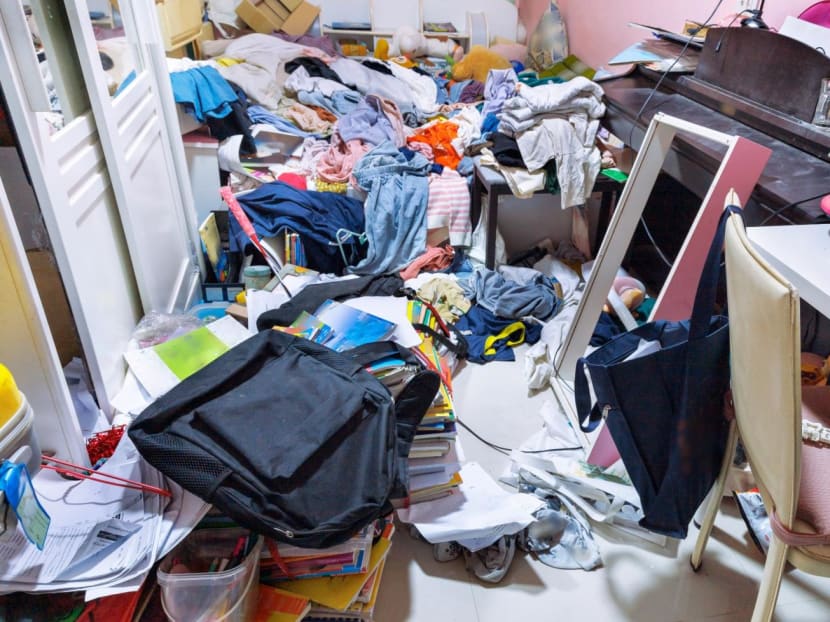260 active hoarding cases being dealt with; difficulties in getting some homeowners to cooperate: MND
SINGAPORE — A multi-agency committee dealing with hoarding problems in Housing and Development Board (HDB) flats has reduced the severity of 210 such cases in the first half of this year, and there is another 260 active cases being dealt with now.

- As of the first half of 2022, 210 hoarding cases have had their severity reduced
- Another 260 active hoarding cases are now being dealt with by a multi-agency committee
- Ms Sim Ann, Senior Minister of State for National Development, said that hoarding cases are complex and may have different root causes
- Dealing with them can be more complicated when the extent of hoarding behaviour do not outrightly breach regulations
- Associate Professor Muhammad Faishal Ibrahim, Minister of State for National Development, said SCDF does not assess cluttered homes "in general" to be a key fire risk
SINGAPORE — A multi-agency committee dealing with hoarding problems in Housing and Development Board (HDB) flats has reduced the severity of 210 such cases in the first half of this year, and there is another 260 active cases being dealt with now.
Ms Sim Ann, Senior Minister of State for National Development, speaking in Parliament on Monday (Sept 12), explained that cases of hoarding can remain “protracted and unresolved” because it may be difficult to get homeowners’ cooperation.
She was responding to parliamentary questions by 10 Members of Parliament (MPs) on the progress made in dealing with hoarding cases and their potential risks to public health and safety.
Just last month, two cases of fire at HDB flats were reported. One such case in Ang Mo Kio on Aug 30 involved discarded items and air-conditioning compressors. On Aug 16, a separate fire incident occurred in Jurong East, causing one death.
The Straits Times reported that neighbours had complained for almost a decade about the hoarding problem at the Jurong East flat.
Ms Sim explained that in some cases where the extent of hoarding does not constitute legal violations, officers on the ground may face difficulties balancing between an individual's right to upkeep their own home however they wish to and neighbours’ enjoyment of their residences.
The root cause of hoarding behaviour can also be complex, she said, such as due to mental health conditions or social factors.
Given the complexity of the issue, the Hoarding Management Core Group (HMCG), led by the Municipal Services Office and comprising various public agencies including HDB, was set up in 2014, she said.
A framework is used to assess cases and these are prioritised based on whether they pose a threat to public health and safety.
Where established rules and laws are violated, regulatory agencies will issue orders or take enforcement action on the hoarder or homeowner, she added.
HMCG also considers social and community interventions in tandem with enforcement efforts, she said, such as by referring hoarders to the Agency for Integrated Care and the Institute of Mental Health for professional assessment and treatment if they are suspected of having mental health conditions.
“However, even with the involvement of mental health agencies and professionals, deep-seated issues may still result in recurrence as behavioural change is unlikely to happen overnight,” Ms Sim said.
In cases where the extent of the hoarding does not outrightly violate existing regulations, officers on the ground need to get the hoarders’ cooperation to help them declutter.
This would involve repeated engagements to persuade homeowners to work with officers to declutter, she explained.
“We have encountered cases where hoarders refuse to open their door for inspections or cooperate in decluttering — some may even threaten self-harm at the thought of losing their belongings,” she added.
Ms Sim Ann said that the agencies empathise with neighbours’ frustrations on the matter and are committed to review enforcement levers and acting more decisively on decluttering efforts.
She gave the assurance that where hoarding cases pose risks, agencies will “act firmly in the interest of public health and safety to intervene”.
Mr Liang Eng Hwa, MP for Bukit Panjang, asked in a supplementary question whether the Singapore Civil Defence Force (SCDF) have the authority to issue decluttering notices to households with excessive hoarding and that pose fire risk, and whether the Ministry of Home Affairs would consider empowering the SCDF with such authority.
In reply, Associate Professor Muhammad Faishal Ibrahim, Minister of State for Home Affairs and National Development, reiterated that SCDF does not assess cluttered homes “in general” to be a key fire risk, and each case has to be assessed individually.
TODAY previously reported that between 2018 and end-September last year, SCDF was alerted to nine residential fires that involved hoarding. This accounts for less than 1 per cent of all residential fires.











